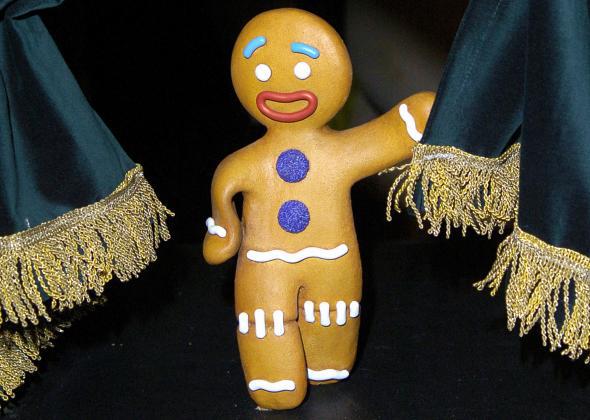Every year around this time, bakers who are not professional contrarians make holiday gingerbread cookies that look like people. There are man-, woman-, and child-shaped cookie cutters available for this exact purpose. Why do we shape gingerbread cookies like people, but not other kinds of cookies?
It’s been going on in Europe since the Middle Ages. Back then, “gingerbread” was an amalgam of bread crumbs, molasses or honey, wine, rosewater, and other miscellaneous ingredients. As unappetizing as this mixture sounds, it was very easy to mold into shapes. In her 2010 cookbook Gingerbread, Jennifer Lindner McGlinn writes, “Communities used these dense cakes to commemorate holidays and celebrations, and the images varied widely depending on the occasion. Flowers and religious symbols, in fact, seem to have been as popular as royal figures and even quite bawdy, scantily clad lovers.” (In other words, the idea behind The Cookie Sutra isn’t as novel as you think.) Gingerbread was believed to have medicinal and vaguely magical properties: In addition to serving as actors in edible proto-porn, gingerbread men were eaten by young women in order to supernaturally attract their future husbands.
In 15th-century Germany, where gingerbread was taken so seriously that one had to belong to a gingerbread guild in order to bake it, Holy Roman Emperor Frederick III distributed gingerbread molded in his likeness as a sort of mass marketing political campaign. England’s Queen Elizabeth I did Frederick one better by commissioning life-sized gingerbread sculptures of royal guests of honor. (Today, gingerbread hearts and horses are the most common shapes for gingerbread cookies in Germany. Judging from the German Wikipedia page for gingerbread, they are rather baffled by our gingerbread men, which are described as having “a simplified human form without hands or feet.”)
The English tradition of gingerbread men made its way to North America via English colonists, who shaped honey-spice cookies like politicians (and other creatures). But the gingerbread man didn’t become a cultural archetype in America until 1875, when a children’s publication called St. Nicholas Magazine published “The Gin-ger-bread Boy,” about a living gingerbread man who runs away from various pursuers—a little old woman, a little old man, a cow, etc.—before he is eaten by a fox. This was not an original story: Folk tales with the same narrative structure but starring other baked good, such as pancakes, had been told orally in Europe for centuries. (Such stories are known among folklore scholars as “Fleeing Pancake” stories.) It’s not clear exactly when the gingerbread man took over the starring role in the folk tale, but the author of the St. Nicholas piece explained how he had originally heard it: “A servant girl from Maine told it to my children. It interested them so much that I thought it worth preserving. I asked where she found it, and she said an old lady told it to her in her childhood.”
By the early 20th century, the living gingerbread man had become so entrenched a figure in American culture that L. Frank Baum chose a gingerbread man as the protagonist of his 1906 novel John Dough and the Cherub. Today, we still see him in such important works as Candy Land and the Shrek series. And, of course, on Christmas cookie platters everywhere.
Thanks to Joanne Lamb Hayes, Jennifer Lindner McGlinn, and Maria Tatar.
